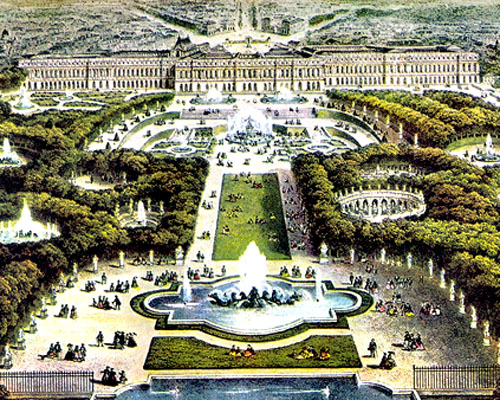| Barokhavernes tid

| | Europas enevældige konger blev i 1700-tallet inspireret af bl.a. Versailles i Frankrig og fik anlagt barokparker, der skulle markere magt og enevælde.
Eksempler på sådanne anlæg er Frederiksborg og Fredensborgs slotshaver samt Marienlyst i Helsingør. |
Frederik 4.s haver
Selve fredsslutningen efter Store nordiske Krig fandt sted på Frederiksborg Slot, hvor den danske konge, Frederik 4..(1699-1728), efter krigsafslutningen 1720 tog fat på at anlægge et omfattende haveanlæg med tilhørende vandkunst.
Ligesom sin far havde kong Frederik som kronprins i 1692-93 været på dannelsesrejse sydpå, gennem Tyskland til Italien og Frankrig, hvor han gæstede solkongen, Ludvig d.14.s hof. Mens Christian 5. hentede inspiration til fornyelse af jagt og hesteopdræt, var det der optog Frederik først og fremmest haveanlæg og gerne med indlagte springvand og kaskader. Dette havde han lejlighed til at iagttage bl.a. ved besøg i renæssancehaver i Norditalien og naturligvis også det imponerende barokanlæg ved Versailles-slottet udenfor Paris.

Versailles |
Frederiksborgs barokhave
Allerede i 1702 begyndte kongen at overveje at fjerne Sparepenge og den tilhørende have for at udnytte det skrå terræn på den anden side af slotssøen til anlæggelse af en større barokhave. 1720 begynder kongen at virkeliggøre sine planer. Sparepenge bliver brudt ned og en del af stenene herfra anvendes til opførelsen af Fredensborg Slot. I årene 1720-25 opføres den nye have efter plan af arkitekten Johan Cornelius Krieger.
Anlægget er på 100x 400 meter, anlagt i tre planer på det skrånende terræn. Venstre side af anlægget er koncentreret om en midterakse, der udgøres af en gennemgående vandkaskade. Anlægget omkring denne akse er symmetrisk beplantet, hvor de lave parterre-bede på første trin udgøres af varierede kongelige monogrammer.

Frederiksborg slotshave | 
Frederiksborg Slots omgivelser |
Havens ide
Anlæggets midterakse afsluttes med en obelisk der i samspil med den vertikale beplantning medvirker til at skabe et optisk bedrag, en fornemmelse af et næsten uendeligt anlæg. Hermed demonstrerer ophavsmanden sin evne til at beherske landskabet og naturen.
Endvidere forlænges den gennemgående akse naturligt over søen til selve slotsanlægget, den enevældige monarks bolig. Samlet er det et udtryk for monarkens kontrol over og beherskelse af natur og kultur i en samlet enhed. Beherskelsen kommer til udtryk ned i de mindste detaljer, gennem den velordnede symmetri og den sirlige klipning af beplantningen. Anlægget skal imponere beskueren og udtrykke den enevældige statsmagt formåen.
Fredensborg Slotshave
Fredensborgs Slots forgænger Østrup var en integreret del af kongens jagtanlæg, faktisk beliggende midt en af parforcejagtanlæggets stjerner, hvor en række anlagte vej mødtes. Dette blev også udgangspunkt for det haveanlæg, som arkitekt og bygmester Krieger tog fat på omkring 1722.
De af hensyn til jagten udhuggede veje i skovlandskabet blev nu omdannet til alleer, som samledes i centrum af hovedbygningens havestue. Tværgående veje blev tilføjet og inderst i denne halvcirkel blev anlagt en række parterre-bede i regelmæssige mønstre, formodentlig beplantet med takstræer, som var hentet fra Jægersborg. Mod vest anlagdes desuden en række firkantede parterre-bede, som bl.a. rummede kongelige monogrammer.
I tilknytning til anlægget skabtes såkaldte runde alleer, herunder den såkaldte Normandsdal, der opføres omkring 1760. Fra samme tidspunkt stammer en detaljeret plan for reorganisering af haven ved den franske arkitekt N.H. 191. I denne fremhæves en centralakse med udgangspunkt i den midterste alle, men de øvrige alleer bibeholdes og samlet dannes der et såkaldt gåsefodsmønster, som f.eks. også genfindes i Versailles-parkens barokke haveanlæg. Anlægget er således fortsat barokt i sin grundstruktur, men Normandsdalen med sandstensfigurer af norske og færøske godtfolk vidner om oplysningstidens interesse for kortlægning og registrering med udgangspunkt i Christian d.6.s Norgesrejse i 1733.

Fredensborg 1729 | 
Jardins plan 1760 | 
Normandsdalen | 
Nordmandsdalen |
Frederiksberg Have
Frederik 4.lod i starten af 1700-tallet også Frederiksberg Slot opføre i umiddelbar nærhed af residensbyen København. Formålet var bl.a. ar skabe et nærrekreativt område for hoffet og til dette hørte naturligvis også en have. Fra omkring 1760 stammer en plan som viser er typisk barokanlæg med et strengt symmetrisk anlæg både foran og bagved hovedbygningen i det nuværende Søndermarken på den anden side af Roskildevej.

Frederiksberg Slot | 
Frederiksberg Have |
Marienlyst Slot og barokhave
Den franske arkitekt Nicholas-Henri Jardin kom oprindelig til Danmark for at udbygge den såkaldte Frederiksstad i midten af København. Planerne herfor blev imidlertid aldrig til noget, men i stedet kom Jardin til at virke i forbindelse med Fredensborg nye haveanlæg omkring 1760 og arbejdede samtidig med en ombygning af det gamle lysthus Lundehave udenfor Helsingør. Jardin valgte at bibeholde det gamle Lundehave som et fremspringende midterparti i en tredelt bygning i klassicistisk stil.
Hermed fik Danmark et tidligt og vellykket bygningsværk i en ny tids stilart. Barokstilen er ved at tone ud, men det iagttages endnu i det tilhørende haveanlæg, der fortsat er strengt symmetrisk anlagt i den barokke, franske havestil.

Marienlyst Slot i Helsingør | 
Moltkes Haveanlæg | 
Marienlyst med have. |
|